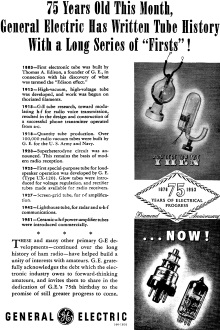General Electric Advertisement |
|
By 1953, General Electric had already been in business for 75 years, according to this full-page advertisement that ran in the American Radio Relay League's (ARRL) QST magazine. It highlights a few key electronics-related accomplishments by the company since Thomas Edison in 1883 built the first electronic tube as the result of a discovery that came to be termed the "Edison effect." Interestingly, the terminology "a founder of G.E." is used to describe Edison. Upon researching the company's origin, I found this on Wikipedia: "In 1889, Drexel, Morgan & Co., a company founded by J.P. Morgan and Anthony J. Drexel, financed Edison's research and helped merge those companies under one corporation to form Edison General Electric Company, which was incorporated in New York on April 24, 1889." 75 Years Old This Month, General Electric Has Written Tube History With a Long Series of "Firsts"!
1913 - High-vacuum, high-voltage tube was developed, and work was begun on thoriated filaments. 1915 - G-E tube research, toward modulating h-f for radio voice transmission, resulted in the design and construction of a successful phone transmitter operated from a-c. 1918 - Quantity tube production. Over 100,000 radio vacuum rubes were built by G. E. for the U. S. Army and Navy. 1923 - Superheterodyne circuit was announced. This remains the basis of modern radio reception. 1925 - First special-purpose tube for loudspeaker operation was developed by G. E. (Type UX-120). Glow tubes were introduced for voltage regulation, and rectifier tubes made for radio receivers. 1927 - Screen-grid tube, for r-f amplification. 1942 - Lighthouse tube, for radar and u-h-f communications. 1951 - Ceramic u-h-f power-amplifier tubes were introduced commercially. * * * These and many other primary G-E developments - continued over the long history of ham radio - have helped build a unity of interests with amateurs. G. E. gratefully acknowledges the debt which the electronic industry owes to forward-thinking amateurs, and invites them to share in the dedication of G.E.'s 75th birthday to the promise of still greater progress to come.
Posted November 6, 2022 |
|

